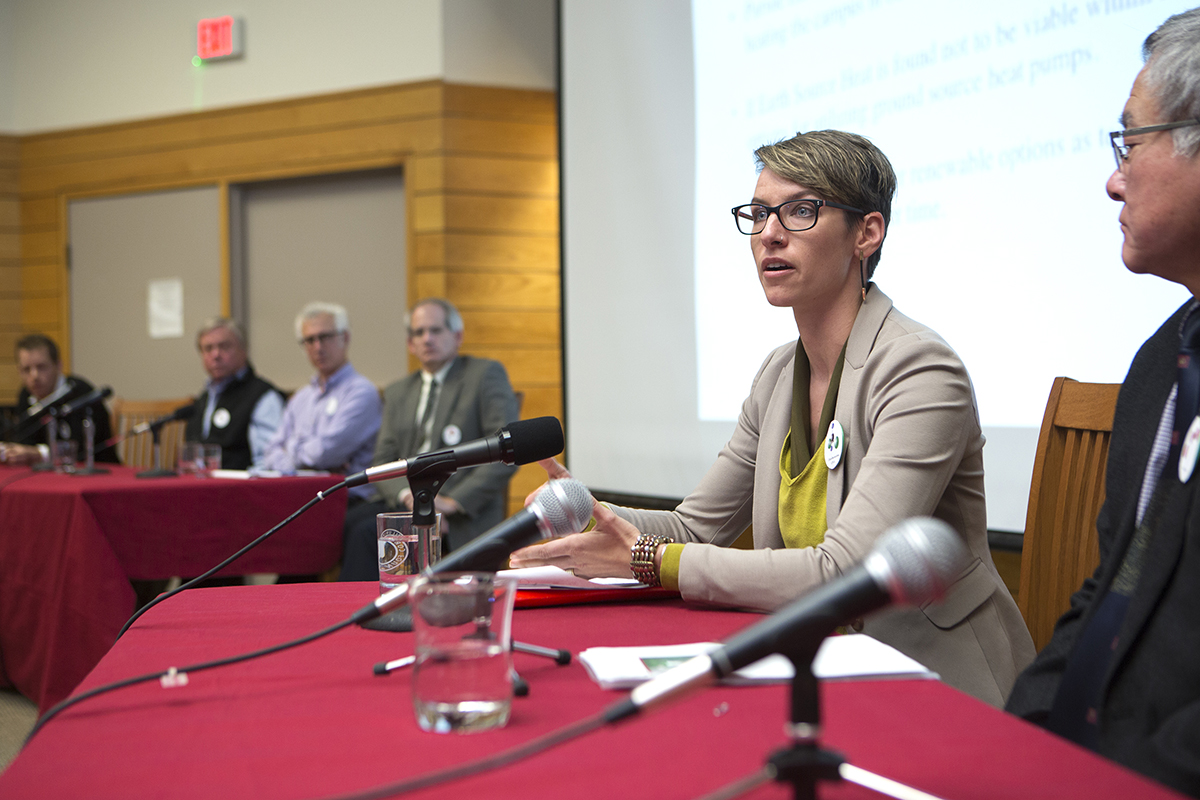Panel outlines action for campus carbon neutrality by 2035
By Blaine Friedlander

With a plan to harness the wind, sun, water and the Earth’s heat, a panel from the Senior Leaders Climate Action Group (SLCAG) explained to the Cornell community Oct. 31 how the campus could become carbon neutral by 2035. They stepped through the financial analysis and feasibility report that was released in October.
“We need to heat and power a ‘Research I’ institution, and we are power hungry,” said Lance Collins, the Joseph Silbert Dean of Cornell Engineering and co-chair of SLCAG. He outlined Cornell’s carbon footprint challenges, which include designing a campus heating system that can accommodate Ithaca’s extreme weather conditions.
The current low cost of fossil fuel makes it difficult to justify future renewable energy projects, Collins said, but the university aims to reduce campus energy demand and increase the number of high-performance buildings. As for fossil fuel energy sources, he explained, “The goal is to drive this to zero.”
In September, the university announced it will study implementing an enhanced geothermal system to heat the entire campus.
KyuJung Whang, vice president for infrastructure, properties and planning, and SLCAG co-chair, also briefed the forum. “We have to lower our energy demands on campus so that our goals become easier to achieve,” he said, noting that Cornell’s buildings consume the most energy. “This is a big nut for us to crack,” he said.
Over the past decade, campus has grown by 1.5 million square feet, but energy consumption has stayed flat, he said. “We were able to achieve that because our buildings have become more efficient and we’re using less energy than 10 or 15 years ago. That’s really a positive story,” he said, and suggested the university continue to invest in energy conservation.
As the floor opened to questions, cost was a concern. With financial figures for earth source heat reaching hundreds of millions of dollars, an audience member asked if philanthropy would pay for the project.
“The dollar figures are enormous, so it’s unrealistic that we’ll do this with philanthropy alone,” Collins said, explaining that philanthropy will play a larger role early on, because there will be a lot of risk. As the project moves along, he said, the risk will decrease in time, and companies will be more interested in investing in “de-risked” technology.
“As the risks go down, interest in technology goes up. We imagine a trade-off happening,” he said.
As the conversation covered various scenarios of achieving carbon neutrality, Todd Cowen, professor of civil and environmental engineering and the Kathy Dwyer Marble and Curt Marble Faculty Director for Energy at Cornell’s David R. Atkinson Center for a Sustainable Future, reminded the audience about the people portion of solution.
“One focus of today’s conversation has been technology, but it is only part of the solution,” Cowen said. Building permits from local governments will be needed, and the local citizens will need to get involved in considering technical solutions.
The campus itself needs to be engaged on the people question, Cowen explained. It is not engineering or facilities that will get us to carbon neutrality, he said, explaining that “it will be the College of Agriculture and Life Sciences, Arts and Sciences, the Law School, the Business College – they’re going to figure out how to deal with the most challenging problems – which involve people.”
Cowen explained that while communities generally favor energy methods that reduce atmospheric carbon dioxide, some people object to having those solutions in their own backyard. Cornell can study this. “The ability to … study why people want solutions – but not-in-my-backyard – is an incredibly powerful opportunity, and we can export that understanding to [other places],” Cowen said. “This is one of the most exciting aspects of the problem. It requires us to think holistically – across every unit of campus – about how to do this.”
Joining Collins, Whang and Cowen on the panel were SLCAG members Sarah Brylinsky, sustainability communications and integration manager; Paul Streeter, vice president for budget and planning; Robert Howarth, the David R. Atkinson Professor of Ecology and Environmental Biology; and graduate student representative Jeffrey Bergfalk, a doctoral candidate in mathematics.
Media Contact
Get Cornell news delivered right to your inbox.
Subscribe